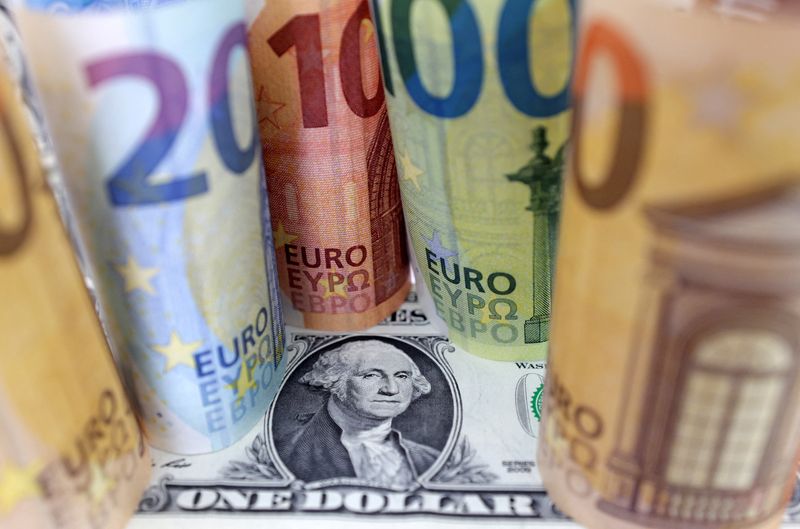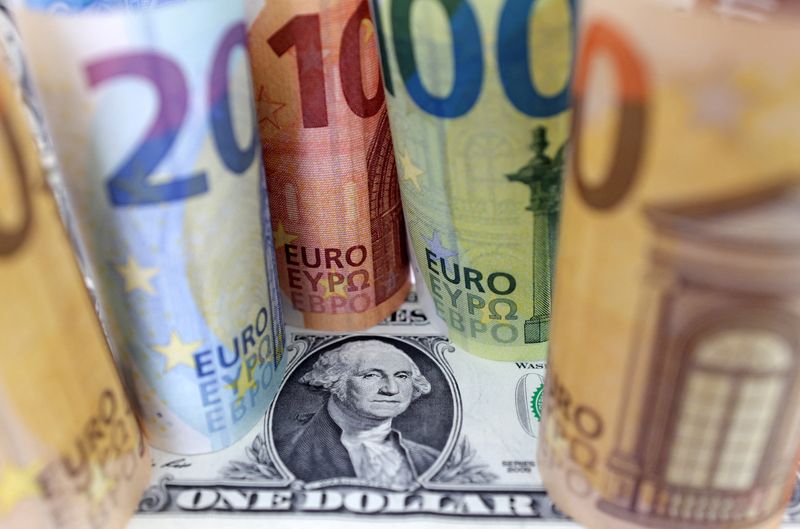Forex
Dollar eases as market shrugs off inflation revision data


© Reuters. FILE PHOTO: U.S. Dollar and Euro banknotes are seen in this illustration taken July 17, 2022. REUTERS/Dado Ruvic/Illustration/File Photo
By Herbert Lash and Amanda Cooper
NEW YORK/LONDON (Reuters) -The dollar eased on Friday as it headed for a fourth week of gains while traders reduced their bets on how quickly the Bank of Japan might raise interest rates and how soon the Federal Reserve will cut them.
Traders shrugged off revised U.S. monthly consumer prices that rose less than initially estimated in December. While underlying inflation remained a bit warm, the mixed picture did not alter the market’s outlook on the timing of Fed rate cuts.
The annual revisions published by the Labor Department also showed the consumer price index (CPI) increasing slightly more than previously reported in October and November.
“The revisions aren’t going to make the Fed cut rates,” said Steven Ricchiuto, U.S. chief economist at Mizuho Securities USA LLC in New York.
“The market’s in a rush, (but) the Fed is sitting there saying we’re not in a rush. Actually, things are really pretty good from their perspective,” he said.
The fell 0.07% to 104.04, while the euro was up 0.08% to $1.0785.
The widely anticipated revisions are more for economists and are too small to matter to the market, said Marc Chandler, chief market strategist at Bannockburn Global Forex in New York.
“We’ve had a big move this week and I think they were just consolidating in the FX market,” he said. “The market last year got too aggressive about how far the Fed’s going to cut and when they’re going to begin.”
Fed officials this week again signaled the U.S. central bank has no pressing need to cut rates. The message gave the dollar an extra tailwind that pushed the yen to a 10-week low as traders reduced bets on how quickly the Bank of Japan (BOJ) might raise rates.
BOJ Governor Kazuo Ueda said on Friday there was a high chance for easy monetary conditions to persist even after the central bank ends its negative interest rate policy, which the market expects to happen as early as next month.
The yen was little changed at 149.32 per dollar after trading at 149.575 earlier, its weakest since Nov. 27. It is heading for about a 0.64% slide this week, having fallen in value in five out of the last six weeks.
Japanese Finance Minister Shunichi Suzuki said he was “watching FX moves carefully,” uttering a well-worn phrase for the first time since Jan. 19. Traders were unfazed by the warning.
The next major scheduled U.S. data release is CPI for January on Tuesday.
Traders have all but ruled out a cut at the Fed’s next policy meeting in March, versus a chance of 65.9% a month ago, according to CME Group’s (NASDAQ:) FedWatch Tool. It shows around a 60% chance of a cut by the Fed at its May meeting.
Sterling rose 0.15% to $1.2635. Both the euro and the pound have been relatively resilient this week, with officials from the European Central Bank and Bank of England pushing back against market wagers on early rate reductions.
The Swiss franc weakened to 0.8747, with the dollar up about 0.93% on the safe haven currency this week as traders digested data suggesting the Swiss National Bank could be intervening in markets to weaken the franc.
rose 4.9% to $47,549.00, after earlier hitting a high of $48,183.

 Forex3 years ago
Forex3 years agoForex Today: the dollar is gaining strength amid gloomy sentiment at the start of the Fed’s week

 Forex3 years ago
Forex3 years agoUnbiased review of Pocket Option broker

 Forex3 years ago
Forex3 years agoDollar to pound sterling exchange rate today: Pound plummeted to its lowest since 1985

 Forex3 years ago
Forex3 years agoHow is the Australian dollar doing today?

 Cryptocurrency3 years ago
Cryptocurrency3 years agoWhat happened in the crypto market – current events today

 World3 years ago
World3 years agoWhy are modern video games an art form?

 Commodities3 years ago
Commodities3 years agoCopper continues to fall in price on expectations of lower demand in China

 Economy3 years ago
Economy3 years agoCrude oil tankers double in price due to EU anti-Russian sanctions





















